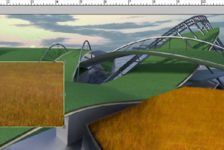Article by Domenico Pistone We examine the term gentrification and take a closer look at what it means to Landscape Architects. It’s a word that now, more and more often, we meet while browsing articles on large cities undergoing transformation. It pops up notoriously around the topic of workers’ quarters; when reading a post on urban regeneration; whilst looking for examples of great world cities like San Francisco, Berlin, New York, or Rome; it is a word that seems far too complex to be understood easily.
So, What the Hell is Gentrification?
Gentrification Definition: “The buying and renovation of houses and stores in deteriorated urban neighborhoods by upper- or middle-income families or individuals, thus improving property values but often displacing low-income families and small businesses”. – www.dictionary.com It is a term coined in 1964 by R. Glass, (1912-1990) a British sociologist of German origin. Fifty-two years since that gentrification definition, you need to look at an overall picture to see a phenomenon that is sometimes associated with any kind of urban regeneration; but all growth is not gentrification. The term derives from the noun, “gentry”, described first as the lower nobility, and, broadly speaking, as people from good families that make up the bourgeoisie. Gentrification is typical of global cities and is often the result of economic change. Since Ruth Glass analyzed this socio-economic phenomenon, the largest debate over issues of gentrification is that concerning the causes of this type of change. Gentrification Meaning There Were Two Main Lines of Thought for Gentrification The first, supported by King’s College professors T.Butler and C.Hamnett, is oriented to the demand side: the society is changing (reflect, perhaps is happening to you, too), the middle class, engaged in more paying jobs, begins to spend money, the economy turns and moves towards closer to work areas. The second, supported by the geographer Neil Robert Smith and the Scottish academics, focuses on the supply side, identifying the devaluation of housing as the engine of gentrification. In both cases, therefore, gentrification leads to the creation of real portions of the city abandoned or left to themselves, as maybe is happening outside our window and we do not know. WATCH >>> Gentrification: The New Age of Colonialism (Documentary)
How to Recognize Gentrification?
Glass claims that the gentrification process includes three different points of view: geographic, social, and housing. From a geographical point of view, when gentrification occurs in a big city, it takes on a neighborhood size and concerns especially deprived areas near the city center. From the social point of view, it assumes the immediate relevance of class membership. As it happens, families or individuals of the middle class go to occupy housing and neighborhoods from which the families of the working class have been expelled. From a construction standpoint, the process involves old, run-down homes, which are recovered and refurbished by the new residents with repercussions on their real estate value. The Glass description suggests an organized process, a plurality of uncoordinated individuals. This theory has been revitalized, in part, by Benjamin Grant (city planner, urban designer and head of the SPUR interagency Master Plan for Ocean Beach). Sociologist Jason Patch, in his book, “The Embedded Landscape of Gentrification“, rethinks the relationship between social environment and buildings, yet confirming the prime arena of gentrification: the city. It is only in the city, in fact, that this socio-cultural and economic process can and does happen. It is the city that allows these changes, driven by the economy, to occur at the speed of a change in fashions and trends. Times Change, Gentrification Does too Of course, in fifty years many things have changed in society. Now, perhaps, the term gentrification is used more commonly and is used to define a much broader concept than it did fifty-two years ago. You could say that we can define gentrification as any urban transformation that has two of the following three characteristics:
- Social concerns
- Building renovations
- A central location
WATCH >>> The Pros And Cons Of Gentrification
Gentrification, however, leads to homogenisation of the areas of design, often stripped of any study linked to the specificity of place, design which is devoid of passion and character. Memory and historical identity give way to economic and sociological drivers that lead to a forced redevelopment of the sites. It is a capitalist and in some respects speculative approach which greatly influences the culture and character of a territory, making gentrification a controversial process. Perhaps we too are endorsing the practice and we do not know it? Many critics say that the most onerous damage caused by gentrification is the displacement of the original inhabitants of a redeveloped area even poorer areas. WATCH >>> Gentrification: Help or Harm?
Let the Past be our Future; the Role of Landscape Architect! Landscape architecture, the practice that often reinterprets historical memory in a contemporary way, may be interested in gentrification, this social and economic cultural process which instead of displacing residents, revitalizes a place, bringing benefits to those who live there now. Gentrification is a process that can hardly be stopped; it is useless to try. Change is inherent in the human soul, said Heraclitus, the ancient Greek philosopher, and one of the greatest pre-Socratic thinkers, “there is nothing immutable, but the need to change”, so why not take advantage of this change to the physical and mental well-being of the residents of a place? That’s why the landscape architect should be interested in gentrification because they are the right people to reinterpret an economic process with a participatory planning process and redevelopment of the sites aimed at improving the lives of residents. Imagine that this healthy change involves every neighbourhood of every city in the world. Imagine the potential contained in every story and how the landscape architect could reassess land development to create a general well-being requested by the affected; by those who are usually required to move because of gentrification. Has this article helped your understanding of gentrification?
Recommended Reading:
- Gentrification by Routledge
- There Goes the ‘Hood: Views of Gentrification from the Ground Up by Temple University Press
Article by Domenico Pistone Featured Image: Buildings on Mainzer Straße in Berlin. By No machine-readable author provided. Gryffindor assumed (based on copyright claims). – No machine-readable source provided. Own work assumed (based on copyright claims)., Public Domain
Published in Blog







